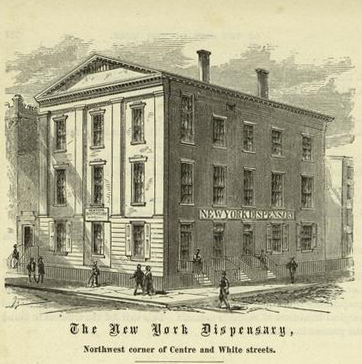Academy’s Past – A Need for More Space
The Lyceum’s third home served as a placeholder until funds were raised for a standalone facility.
Published September 16, 2024
By Nick Fetty
Digital Content Manager
New York Dispensary | White Street and Center Street | 1831 – 1836
The Lyceum of Natural History in the City of New York (“the Lyceum”) called the New York Dispensary home from 1831 to 1836. The Lyceum – which would rename itself The New York Academy of Sciences in 1876 – procured space on the third floor to house its cabinets and library, in addition to meeting rooms and office space. The lease dictated an annual rental rate of $150 (more than $5000 today) to be paid in quarterly installments.
Unlike cannabis-selling dispensaries that have popped up recently in various cities in the U.S., the New York Dispensary in the early 19th century was more akin to a religion-affiliated hospital that served those without financial means. It dispensed vaccines and other medical drugs to improve public health for the city’s most vulnerable populations. According to the Dispensary’s 1837 annual report, “The Institution is founded for, and dispenses its assistance only to the poor.”
An Immediate Need for More Space
Almost immediately upon moving into the new facility, Lyceum officials pursued a plan to purchase a piece of land on which to erect a new building and home. When attempts to collaborate on a building project with related institutions like the New York College of Pharmacy and the Mechanics’ Institute proved fruitless, the Lyceum decided to go it alone.
In 1834, John C. Jay, a curator for the Lyceum, led a successful effort to raise funds to purchase land and, eventually, construct a new building. Jay recommended the purchase of a 50- by 100-foot plot of land on Broadway between Houston and Prince Streets for approximately $22,000 (nearly $800,000 today). Individual contributors to the project funding were granted Lyceum membership that included access to the Lyceum’s library, as well as free admission to its museum and lectures for donors and their families.
Despite the success of the fundraising campaign, some members expressed concern about the Lyceum’s ability to pay off the debt that would be incurred. Nevertheless, the Lyceum proceeded with the project, which was “speedily completed,” and it moved into the new facility in May 1836.
This is the third piece in an eleven-part series exploring the Academy’s past homes. Read:

